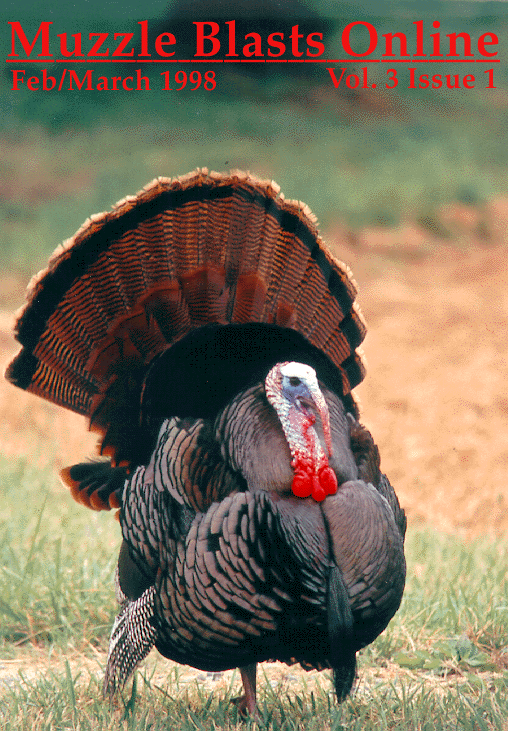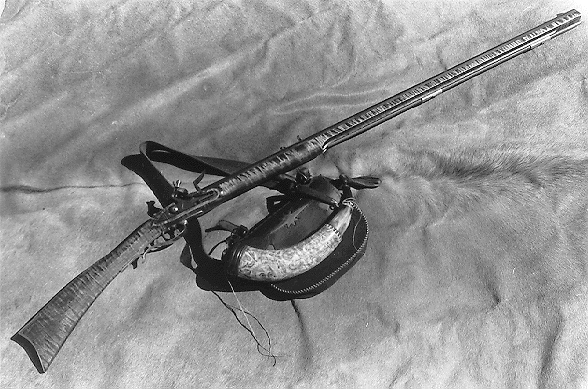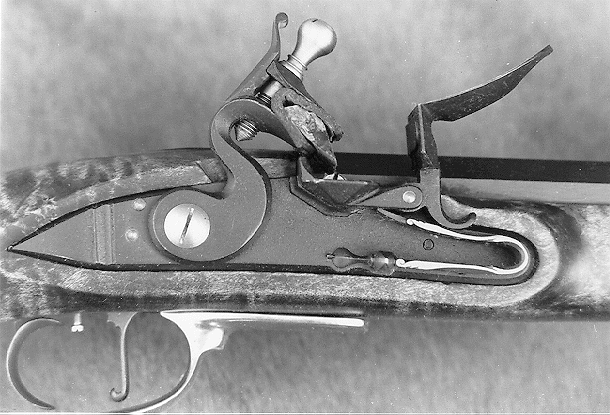|
Muzzle Blasts Online |
|
...for the muzzleloading enthusiast |
|
The muzzleblasts.com domain, subdomains, content, etc., are neither affiliated with the NMLRA nor its paper magazine Muzzle Blasts |
|
Muzzle Blasts Online |

|
|
|
|
|
|
The Hatfield Kentucky Rifle
Editor's Note: Missouri River Rifle Works has recently stopped manufacturing this rifle. Please address all inquiries regarding the rifle to the manufacturer.
Some years back, Ted Hatfield began building a pretty good reproduction Kentucky-style rifle down in St. Joseph, Missouri. The gun was a close copy of rifles built by his great-great-grandfather, Moses Hatfield. If you seem to recognize the name, well you should.

|
|
The Hatfield Rifle
|
At any rate, the Hatfield rifle was pretty well received and several were sold, when due to one thing or another, the company went dormant for a while. It has recently been bought out by Missouri River Rifle Works, 224 North 4th St., St Joseph, Missouri 64501. They are making the same basic rifle as before with a few changes in components.
The full-stocked Southern-style rifles all utilize select curly maple. The guns balance and point well. Relief cuts parallel to the ramrod extend from the entry pipe to the muzzle end of the wood, giving a long, thin look to a forend that is rather wide for this style rifle. The overall effect is a graceful, well designed rifle.
The overall length is 54+ inches with a 13+-inch pull and 3+-inch drop at the heel. The guns are available in .36 caliber with a 1:48 twist and in .45 and .50 calibers with a 1:70 twist. These are definitely round ball guns. The barrel is 39 inches long. A .32 caliber with a 13/16 inch barrel is also available as a custom shop option, as are silver or brass inlays, brass nose caps, patch boxes, engraving, adjustable rear sights, and iron hardware.
Guns come standard with brass buttplate, trigger guard, and ramrod ferrules, and a plain, uncapped forend. Iron sights are standard blade front and buckhorn rear. Set triggers, styled correctly for the rifle, complete the system.

|
|
The excellent L&R lock is well designed and gives reliable ignition
|
When asked to evaluate this rifle, I requested a flintlock in .50 caliber for a couple of reasons. First, it doesn't take much of a lock to crush a percussion cap. A bent nail and rubber band can be made to work. A flintlock, on the other hand, has to be of pretty good quality to produce dependable ignition time after time. Hence, I like to evaluate flint versions whenever possible. The reason for the larger caliber is that many of these guns with fairly severe drop are pretty to look at but serious cheek bone attackers when shot in heavy-recoiling calibers. I'm built with long arms and a neck like an ostrich, so they tend to get after me worse than most.
I'm happy to report that the lock, typical of L & R products, sparks very well and I experienced no problems with it. It was sure-fire every time, assuming that I did my part by keeping a sharp flint. The set triggers were solid and broke cleanly, again pretty much what one would expect from an L & R product.
When I received the rifle, I wiped the barrel free of oil preparatory to shooting. There was a definite obstruction in the vicinity of the touch hole liner. On pulling the breech plug, it was noted that the touch hole liner extended into the bore of the barrel for something like a sixteenth of an inch. While this would probably have little effect upon shooting, it certainly would make it nearly impossible to clean past the touch hole and would lead to a build up of fouling and other gunk between breech plug face and touch hole liner. I removed the touch hole liner and shortened it so that it was no longer that the thickness of the barrel wall. While I had it out, I also coned the inside a bit more.
The double set triggers are double acting, that is, the lock can be tripped with the front trigger unset. This is an important safety feature as the lock can be uncocked without having to deal with a set hair trigger. It's also handy for hunting as the front trigger can be held back as the gun is cocked and then released with the hammer held firmly back. The hammer is then lowered into the full cock notch. This eliminates the click when the lock is cocked. That's a handy trick when that big buck is close enough to hear you cock your rifle.
After working over the touch hole liner, I took the gun to the range for the true test. Would it shoot? Lock time and ignition were very fast and accuracy was very good with no breaking-in required for good groups. This is what I have come to expect from Green Mountain barrels over the years. I've never had a problem with any of their barrels and I've shot a bunch of them.
I used a .490 Hornady swedged round ball patched with .015" Ox-Yoke Wonder Patches. Loads ranged from 65 to 100 grains Elephant brand 3Fg. All loads shot well. I was able to hold 100-yard groups of a couple of inches quite easily. This is about as well as I'm capable of shooting with open sights and eyes considerably over 40. Recoil was very tolerable. The stock handles it very well and I found it a fun gun to shoot. In fact, I enjoyed the little rifle so much that after the work session at the range was over, I took horn and pouch and spent a couple of hours walking the woods and creek shooting at knots on stumps and dirt clods at various distances. The gun shoots and handles well.
I was impressed by the workmanship and quality of this rifle. Other than the touch hole liner glitch, the rifle shoots well out of the box. The front sight is higher than required, making the rifle shoot low, but this is a plus, to my way of thinking. After you work up the load you intend to use and get good shot groups, it is a small matter to file a bit off the front sight to bring the group up to your point of aim. The sights are not adjustable so the tall front sight allows you to adjust for your particular load and sight picture. Shooters often see open sights differently and use different sight pictures. Not much can be done with a short front sight that causes you to shoot high.
Missouri River Rifle Works also makes a half-stocked rifle called The Hatfield Hawken. This one sports a Mowry Gun Works barrel and L & R Hawken-style lock. Stock style is basically the same as the full stock rifle. The .50 caliber barrel is 32 inches long, one inch across the flats, and features a steel under rib and Hawken-style breech. This one is available from the Custom Shop. They also offer a "Blanket Gun" cut-down version of the full-stock rifle called the Companion.
The Hatfield Kentucky Rifle sells for around $900.00, so it is not a cheap starter-type gun. It is, however, a well made, accurate rifle with good components used in its manufacture. It's entirely American made and has some tradition behind it. As Ted Hatfield said some years back, "It's not a reproduction. It's a continuation of production after a few years' recess."